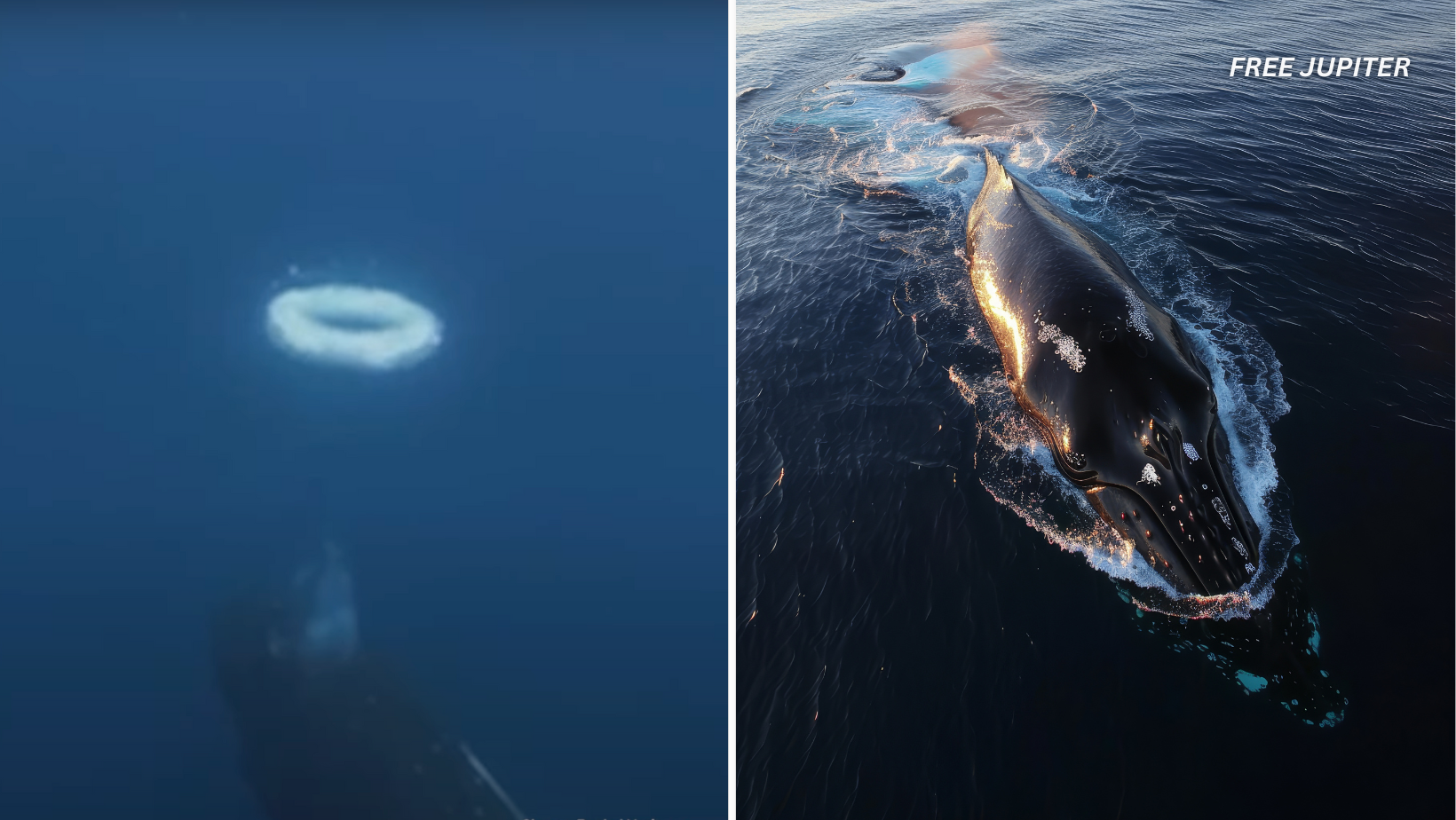Friendly Note: FreeJupiter.com shares general info for curious minds 🌟 Please fact-check all claims—and always check health matters with a professional 💙
Humpback whales have long captivated scientists and ocean enthusiasts alike with their intelligence, complex social structures, and mesmerizing behaviors. Beyond their famous songs and spectacular breaches, these gentle giants are now revealing an even more intriguing facet: their apparent attempts to communicate with humans through playful and deliberate bubble ring displays.
Recent research conducted by the SETI Institute and collaborators from the University of California sheds new light on this remarkable phenomenon, suggesting that humpbacks may be initiating non-verbal conversations with us, expanding our understanding of interspecies communication and intelligence.
The Art of Bubble Rings: More Than Just a Hunting Tool
Humpback whales are well known for their cooperative hunting techniques, particularly their use of bubbles to corral prey. By blowing bubbles underwater, they create circular “nets” that trap schools of small fish, making them easier to catch. This behavior, observed and documented extensively, reflects a sophisticated level of teamwork and communication within whale pods.
However, the recent studies reveal that bubble rings serve purposes beyond hunting. These spinning, air-filled vortices—resembling giant smoke rings about a meter in diameter—are now observed during friendly encounters with humans, seemingly as playful gestures or communicative signals. Unlike the bubble nets used to trap fish, these bubble rings are produced deliberately and directed toward boats and swimmers, indicating a possible attempt by the whales to engage, observe human reactions, or initiate interaction.
Twain and the Underwater Dialogue: A Conversation with a Whale
In 2021, a pioneering experiment by the SETI Institute involved an adult female humpback whale named Twain in Southeast Alaska. Researchers played recorded whale calls through underwater speakers, to which Twain responded with her own vocalizations, effectively engaging in a 20-minute acoustic exchange. This interaction was carefully analyzed and divided into three behavioral phases: engagement, agitation, and disengagement. The findings revealed that Twain was not merely reacting but actively participating in the “conversation,” adjusting her call timing in response to the playback.
This breakthrough demonstrated that humpbacks possess the ability for acoustic turn-taking and vocal matching—key components of complex communication systems. It also opened new possibilities for decoding whale language and understanding how these creatures use sound to convey information, emotions, or intentions.
Read more: Research Shows That Crows Hold Their Own Funerals When One Of Them Dies
Bubble Rings as Playful Communication: A New Dimension
Building on the acoustic findings, a 2024 study documented humpbacks producing large bubble rings during voluntary, friendly interactions with humans. The whales were observed blowing these rings in the direction of boats and swimmers, with many individuals approaching voluntarily to display this curious behavior. Researchers analyzed 12 bubble ring episodes involving 11 whales worldwide, noting a total of 39 rings produced during these encounters.
The whales’ control over the bubble rings is impressive—they actively manipulate their size, depth, and spin, demonstrating a degree of intentionality. This suggests that the bubble rings are not accidental but purposeful signals that may function as invitations to play, tests of human responsiveness, or a novel form of non-verbal communication.
Dr. Fred Sharpe, co-lead author and UC Davis affiliate, remarked that humpbacks live in complex societies, exhibit acoustic diversity, use bubble tools, and even assist other species under threat. The bubble rings directed at humans resemble “candidate signals” in the search for extraterrestrial intelligence—signals that stand out from background noise and may carry meaningful information.
Why Study Whale Communication? The SETI Institute’s Unique Perspective
The SETI Institute’s mission is to explore the origins and prevalence of life and intelligence in the universe. Their interest in humpback whales stems from the broader goal of understanding non-human intelligence and communication systems on Earth as analogs for potential extraterrestrial life.
Laurance Doyle, a SETI scientist and co-author of the recent study, explained that current technology limits the search for alien intelligence to signals aimed at human receivers. Observing the independent evolution of curiosity and communication in humpbacks supports the assumption that intelligent life, wherever found, might seek contact through recognizable signals. Studying whale communication not only enriches our knowledge of Earth’s biodiversity but also helps refine methods for detecting and interpreting signals from beyond our planet.
Read more: First Time in 30 Years: Scientists Have Discovered A New Class Of Antibiotics
Complex Social Lives and Acoustic Diversity
Humpback whales are social creatures, living in dynamic pods with intricate interactions. Their vocalizations are diverse and structured, with recent research revealing statistical patterns in their songs that resemble aspects of human language. These songs are not random but follow complex sequences that can change over time, indicating cultural transmission among whale populations.
Moreover, humpbacks display behaviors such as bubble blowing to assist other species being harassed by predators, highlighting their empathy and social awareness. Their inquisitive and friendly behavior toward humans—often approaching boats and swimmers—further illustrates their cognitive sophistication and curiosity.
The Role of Technology and AI in Decoding Whale Language
Researchers are leveraging advances in bioacoustics, underwater recording technology, and artificial intelligence to analyze whale sounds and behaviors more precisely. The goal is to develop “intelligence filters” capable of parsing complex communication signals, whether from whales or potential extraterrestrial sources.
Interactive bioacoustic playback experiments, like those with Twain, provide valuable insights into how whales respond to dynamic and adaptive stimuli. These methods emphasize the importance of salient, contextually relevant signals to engage non-human intelligences effectively.
By refining these tools, scientists hope to decode the meaning behind whale calls and bubble signals, potentially unlocking a new language of the ocean. This research could transform our understanding of animal intelligence and open new avenues for interspecies communication.
Humpback Whales in Coastal Waters: A Growing Connection
Humpback whales are increasingly observed along the northern coasts of the UK and other regions during their seasonal migrations between Arctic feeding grounds and tropical breeding areas. Their spectacular breaches and bubble ring displays add to the richness of their communicative behaviors witnessed by humans.
These encounters provide unique opportunities for scientists and the public to witness firsthand the whales’ attempts to connect, highlighting the importance of protecting their habitats and ensuring safe, respectful human interactions.
Read more: The Story Behind The Cat Who Walked Off the Titanic, And Lived
Looking Ahead: Bridging Worlds Through Communication
The discovery that humpback whales may be intentionally communicating with humans through bubble rings and vocal exchanges invites us to reconsider the boundaries between species. These findings challenge us to listen more attentively to the natural world and recognize the intelligence and curiosity that exist beyond our own kind.
As research progresses, the playful bubble rings of humpbacks could serve as a metaphorical and literal bridge—linking human curiosity with the mysteries of life on Earth and potentially beyond. The lessons learned from these oceanic conversations may one day help humanity interpret signals from distant worlds, expanding our understanding of intelligence across the cosmos.
In sum, the emerging evidence of humpback whales engaging humans with bubble rings and vocalizations reveals a captivating chapter in the story of animal intelligence. These gentle giants are not only masters of the ocean but also eager participants in a dialogue that transcends species, inviting us to explore the depths of communication and connection in new and profound ways.










